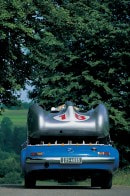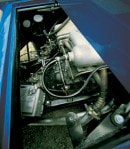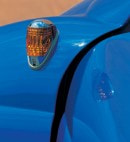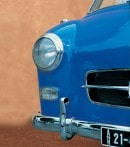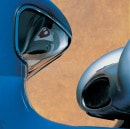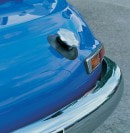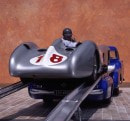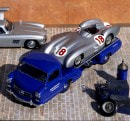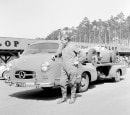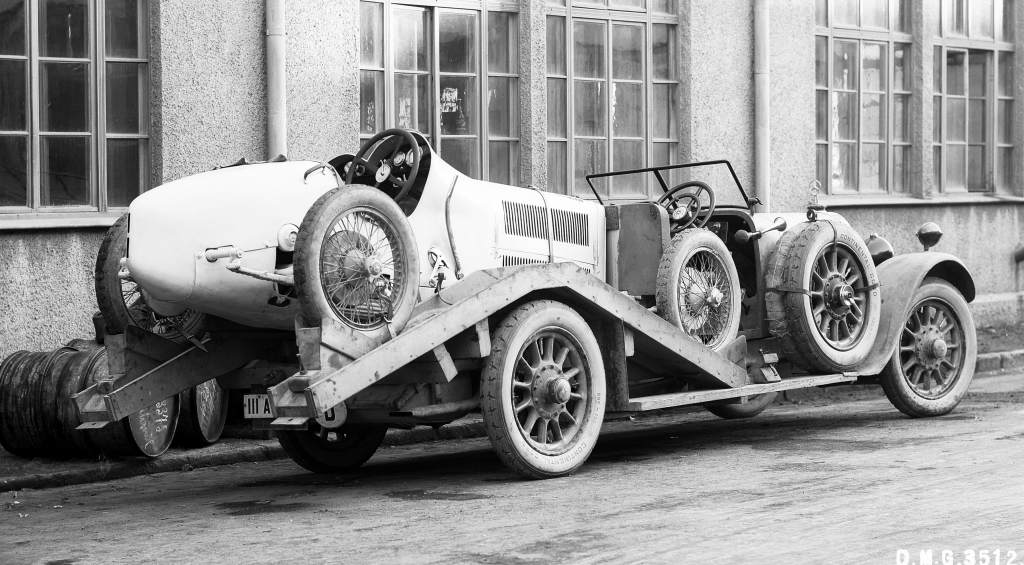← Continued from Page 1 of "Mercedes Renntransporter - The Fastest Racing Car Hauler in the World"The engineering team had to make sure that the vehicle should be very fast and reliable whether it was carrying a racing car or not, so demands were simple albeit very high. With the engineering knowhow of different types of specialists and virtually an unlimited budget, the impossible became possible in a very short time. The result was the spectacular-looking blue transporter that soon became hot topic on everyone closely observing the Grand Prix racing scene of the 1950s.
In order to provide ample space for the racing car which was to be loaded in the rear, the Typ 300 tubular frame was extended, while the inline six cylinder engine with direct injection from the 300 SL was installed right on top of the front axle, connected with the synchronized four speed manual transmission. The whole thingamajig weighed three tonnes without cargo, but its braking power wasn't compromised thanks to hydraulic drum brake system on all fours and a pneumatic brake booster from Bosch.
Ready in mid-1954, the blue aerodynamic truck was mainly used for special duties - like getting a racing car as fast as possible to the track after some last-minute adjustments or to bring a damaged car to the garage in order to cut down on the repair time. Its looks brought so much success that at one time it even battled for newspaper headlines with the actual racing cars it was built to haul. At the end of 1955 it was even borrowed to conduct a tour through America, to be featured in a number of car shows. The vehicle's unusually streamlined body created tonnes of controversy as to what its top speed actually was, until someone painted "Top speed 105 mph" on one of the rear fenders.
Sadly, after the world's most horrific motorsport accident in history that happened at the 1955 edition of the Le Mans 24 Hours, Mercedes-Benz withdrew from racing completely (for quite a while), and so the Renntransporter remained jobless. Thanks to its gathered fame, the original intention was for it to be placed in the old Mercedes-Benz Museum while carrying a 300 SLR, but because the combined weight of the two cars would have exceeded the load-bearing capacity of the building's floor, the idea was dropped.
After a small stint of doing special jobs which helped the road-testing of prototype cars, the world's fastest racing car transporter was finally scrapped in December 1967. Since there weren't any plans available for the vehicle's construction, its legend remained forgotten until 1993, when Mercedes-Benz Classics decided to rebuild it based on all the classic photos and old information that could be gathered. Expert builders spent almost 6000 hours of work and after seven long years the Renntransporter was finally rebuilt from scratch. The resulting car has now found a place in the new Mercedes-Benz Museum, hauling a 300 SLR for eternity.
In order to provide ample space for the racing car which was to be loaded in the rear, the Typ 300 tubular frame was extended, while the inline six cylinder engine with direct injection from the 300 SL was installed right on top of the front axle, connected with the synchronized four speed manual transmission. The whole thingamajig weighed three tonnes without cargo, but its braking power wasn't compromised thanks to hydraulic drum brake system on all fours and a pneumatic brake booster from Bosch.
Ready in mid-1954, the blue aerodynamic truck was mainly used for special duties - like getting a racing car as fast as possible to the track after some last-minute adjustments or to bring a damaged car to the garage in order to cut down on the repair time. Its looks brought so much success that at one time it even battled for newspaper headlines with the actual racing cars it was built to haul. At the end of 1955 it was even borrowed to conduct a tour through America, to be featured in a number of car shows. The vehicle's unusually streamlined body created tonnes of controversy as to what its top speed actually was, until someone painted "Top speed 105 mph" on one of the rear fenders.
Sadly, after the world's most horrific motorsport accident in history that happened at the 1955 edition of the Le Mans 24 Hours, Mercedes-Benz withdrew from racing completely (for quite a while), and so the Renntransporter remained jobless. Thanks to its gathered fame, the original intention was for it to be placed in the old Mercedes-Benz Museum while carrying a 300 SLR, but because the combined weight of the two cars would have exceeded the load-bearing capacity of the building's floor, the idea was dropped.
After a small stint of doing special jobs which helped the road-testing of prototype cars, the world's fastest racing car transporter was finally scrapped in December 1967. Since there weren't any plans available for the vehicle's construction, its legend remained forgotten until 1993, when Mercedes-Benz Classics decided to rebuild it based on all the classic photos and old information that could be gathered. Expert builders spent almost 6000 hours of work and after seven long years the Renntransporter was finally rebuilt from scratch. The resulting car has now found a place in the new Mercedes-Benz Museum, hauling a 300 SLR for eternity.
